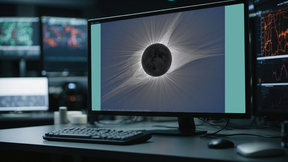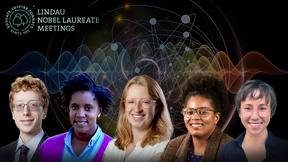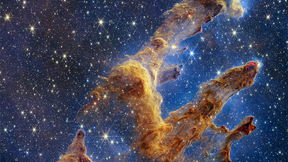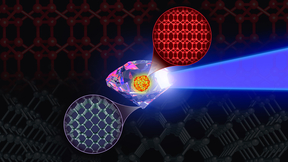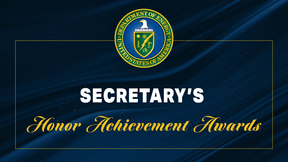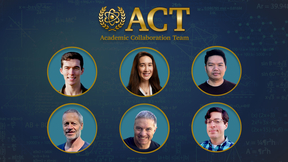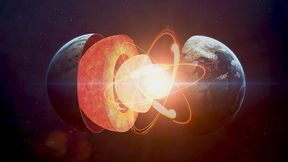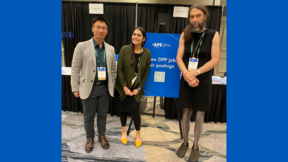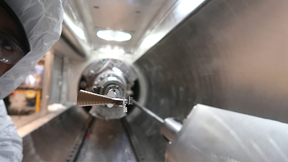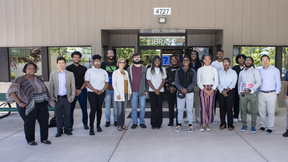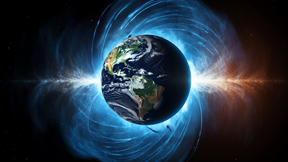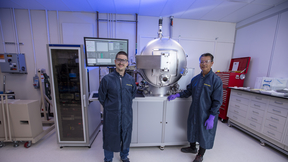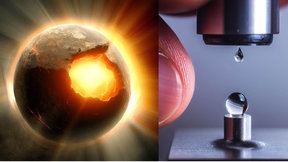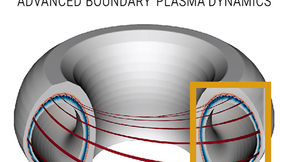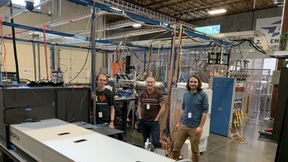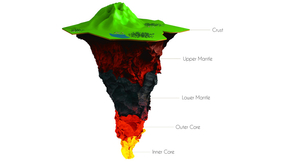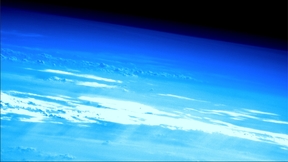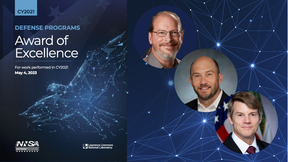Back
On Monday, April 8, a swath of North America will experience a total solar eclipse. For a few minutes, the moon will completely obscure the sun and viewers will be able to see the intricate loops and flares in the solar corona—normally washed out by the bright disk of the sun. In the corona, the outermost, gaseous part of the sun’s atmosphere, particles dance around…
Getting the chance to meet and mingle with scientists who have achieved Nobel Prize winning greatness will be the reality for five Lawrence Livermore National Laboratory (LLNL) postdoctoral appointees selected to attend the 73rd annual Lindau Nobel Laureate meetings. Tina Ebert, Elizabeth Grace and Raspberry Simpson were selected as the 2024 LLNL cohort; Tomi Akindele and…
Editor’s note: The principal mission of Lawrence Livermore National Laboratory (LLNL)’s National Ignition Facility (NIF) is to support the National Nuclear Security Administration’s science-based Stockpile Stewardship Program — and with the achievement of fusion ignition in 2022 at NIF, LLNL is further exploring the possible use of nuclear fusion as a future energy source…
Diamond is the strongest material known. However, another form of carbon has been predicted to be even tougher than diamond. The challenge is how to create it on Earth. The eight-atom body-centered cubic (BC8) crystal is a distinct carbon phase: not diamond, but very similar. BC8 is predicted to be a stronger material, exhibiting a 30% greater resistance to compression…
Lawrence Livermore National Laboratory (LLNL) employees, participating in five project teams, recently earned Department of Energy (DOE) Secretary’s Honor Awards. In addition, Karin King of the Livermore Field Office was honored for her role in the Leadership in Climate Action Team. Representing some of the highest internal, non-monetary recognition that DOE employees and…
Six scientists at the Lawrence Livermore National Laboratory (LLNL) were recently granted awards through the Lab’s 2023 Academic Collaboration Team (ACT) annual call for proposals. Awards support university research partners for up to three years to perform research in collaboration with Lab scientists and offer an important way to build long-term connections with…
Iron is one of the world’s most abundant elements and a primary component of the Earth's core. Understanding the behavior of iron under extreme conditions, such as ultra-high pressures and temperatures, has implications for the science of geology and the Earth’s evolution. In a study conducted by a team led by Lawrence Livermore National Laboratory. researchers combined…
PLS staff physicists Ben Zhu and Veronika Kruse were selected by the American Physical Society (APS) as Career Mentoring Fellows for 2023-2024. Ben belongs to PLS’s Fusion Sciences program and Veronika is in the High Energy Density Science section. Part of their duties involve attending selected APS conferences such as the Division of Plasma Physics (DPP) meeting,…
A new satellite called XRISM (X-ray Imaging and Spectroscopy Mission, pronounced “crism”) was successfully launched from the Tanegashima Space Center in Japan on Sep. 7, 2023. XRISM is a collaboration between the Japan Aerospace Exploration Agency (JAXA) and National Aeronautics and Space Administration (NASA), with European Space Agency participation, to study extreme…
In new experiments at Lawrence Livermore National Laboratory’s National Ignition Facility, scientists measured the extended X-ray absorption fine structure (EXAFS) of copper to probe its temperature under extreme pressure. The research appears in the journal Nature Communications. Dynamic compression experiments at high-energy-density laser facilities have expanded the…
For the second consecutive year, Lawrence Livermore National Laboratory (LLNL) hosted a group of student scholars and faculty members from Historically Black Colleges and Universities (HBCUs) on a recent five-day visit. LLNL’s goal is to develop the next wave of summer interns — and to build a strong pipeline of talent — from historically marginalized groups in science,…
Lawrence Livermore National Laboratory (LLNL) scientists Manyalibo “Ibo” Matthews and Frank Graziani have been named 2023 American Physical Society (APS) fellows. Matthews was selected from the Forum in Industrial and Applied Physics unit “for pioneering research in optimizing metal 3D printing and laser materials processing.” Frank Graziani was chosen from the Division of…
A typical high-school science class teaches that Earth’s core is comprised of two parts: an inner core that is composed mainly of solid iron and an outer core that is composed mainly of molten, liquid iron. Although this is common knowledge, the location of the boundary between the solid inner core and liquid outer core, as well as many other facets of Earth’s deep…
Lawrence Livermore National Laboratory (LLNL) researchers have adapted their novel metasurface process, which creates a thin layer on the surface of an optic, to create an all-glass metasurface with birefringence, or dual refraction, properties. This achievement could transform waveplate technology for high-power laser systems such as the National Ignition Facility (NIF)…
Scaling laws are like a secret code used across science to break down complex phenomena into simple mathematical expressions. These equations help us to understand how one factor in a system relates to other factors that determine the system’s behavior. For example, Kleiber’s Law, one of the best-known scaling laws, observes that metabolic rates of many organisms — from…
A Lawrence Livermore National Laboratory-led project aimed at using computing tools to improve understanding of fusion plasma dynamics was among 12 projects recently awarded funding by the Department of Energy (DOE) to accelerate fusion power plant development. The four-year, multi-institutional Advanced Boundary Plasma Dynamics (ABOUND) project will receive $9.25 million…
Scientists at Lawrence Livermore National Laboratory (LLNL) collaborated with University of California San Diego (UCSD) to design, assemble, and field a portable optical Thomson scattering diagnostic system for the Advanced Research Projects Agency-Energy (ARPA-E) — a Department of Energy agency which supports private companies that are developing new ways to generate,…
Iron monoxide (FeO), also known as wüstite in its mineral form, is a significant (even if not predominant) component of Earth’s core and the deep interior of Earth and other planets. Most notably, FeO exhibits a richness of condensed-matter phenomena, including crystal-structural phase transformations and melting, electronic transitions, and spin-state transitions that…
When SpaceX’s Dragon spacecraft docked with the International Space Station (ISS) on March 16, it delivered several thousand pounds of supplies for the crew as well as new hardware. The hardware included the U.S. Space Force’s Space Test Program Houston 9 (STP-H9) platform, which houses a prototype telescope designed and built by Lawrence Livermore National Laboratory's…
In virtual ceremonies held May 4 and June 26, Marvin Adams, deputy administrator for Defense Programs at the National Nuclear Security Administration (NNSA), honored individuals and teams at Lawrence Livermore National Laboratory (LLNL) and partner sites for their outstanding contributions to nuclear security. The Defense Programs Awards of Excellence recognition events…

